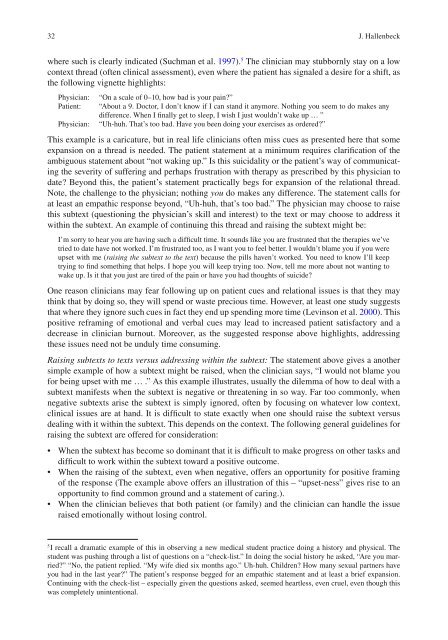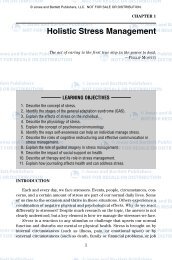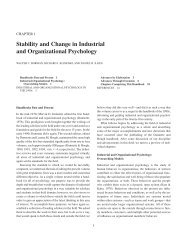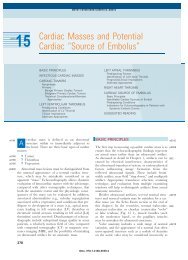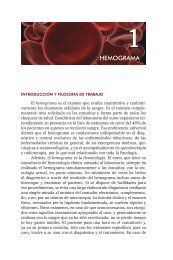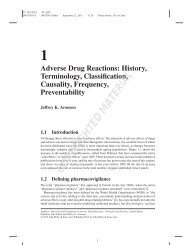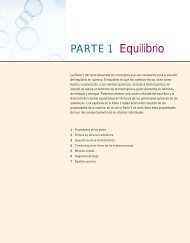Download Sample pages 1 (pdf, 195 kB) - Springer
Download Sample pages 1 (pdf, 195 kB) - Springer
Download Sample pages 1 (pdf, 195 kB) - Springer
Create successful ePaper yourself
Turn your PDF publications into a flip-book with our unique Google optimized e-Paper software.
32 J. Hallenbeck<br />
where such is clearly indicated (Suchman et al. 1997 ) . 5 The clinician may stubbornly stay on a low<br />
context thread (often clinical assessment), even where the patient has signaled a desire for a shift, as<br />
the following vignette highlights:<br />
Physician: “On a scale of 0–10, how bad is your pain?”<br />
Patient: “About a 9. Doctor, I don’t know if I can stand it anymore. Nothing you seem to do makes any<br />
difference. When I fi nally get to sleep, I wish I just wouldn’t wake up … ”<br />
Physician: “Uh-huh. That’s too bad. Have you been doing your exercises as ordered?”<br />
This example is a caricature, but in real life clinicians often miss cues as presented here that some<br />
expansion on a thread is needed. The patient statement at a minimum requires clarifi cation of the<br />
ambiguous statement about “not waking up.” Is this suicidality or the patient’s way of communicating<br />
the severity of suffering and perhaps frustration with therapy as prescribed by this physician to<br />
date? Beyond this, the patient’s statement practically begs for expansion of the relational thread.<br />
Note, the challenge to the physician; nothing you do makes any difference. The statement calls for<br />
at least an empathic response beyond, “Uh-huh, that’s too bad.” The physician may choose to raise<br />
this subtext (questioning the physician’s skill and interest) to the text or may choose to address it<br />
within the subtext. An example of continuing this thread and raising the subtext might be:<br />
I’m sorry to hear you are having such a diffi cult time. It sounds like you are frustrated that the therapies we’ve<br />
tried to date have not worked. I’m frustrated too, as I want you to feel better. I wouldn’t blame you if you were<br />
upset with me ( raising the subtext to the text ) because the pills haven’t worked. You need to know I’ll keep<br />
trying to fi nd something that helps. I hope you will keep trying too. Now, tell me more about not wanting to<br />
wake up. Is it that you just are tired of the pain or have you had thoughts of suicide?<br />
One reason clinicians may fear following up on patient cues and relational issues is that they may<br />
think that by doing so, they will spend or waste precious time. However, at least one study suggests<br />
that where they ignore such cues in fact they end up spending more time (Levinson et al. 2000 ) . This<br />
positive reframing of emotional and verbal cues may lead to increased patient satisfactory and a<br />
decrease in clinician burnout. Moreover, as the suggested response above highlights, addressing<br />
these issues need not be unduly time consuming.<br />
Raising subtexts to texts versus addressing within the subtext: The statement above gives a another<br />
simple example of how a subtext might be raised, when the clinician says, “I would not blame you<br />
for being upset with me … .” As this example illustrates, usually the dilemma of how to deal with a<br />
subtext manifests when the subtext is negative or threatening in so way. Far too commonly, when<br />
negative subtexts arise the subtext is simply ignored, often by focusing on whatever low context,<br />
clinical issues are at hand. It is diffi cult to state exactly when one should raise the subtext versus<br />
dealing with it within the subtext. This depends on the context. The following general guidelines for<br />
raising the subtext are offered for consideration:<br />
• When the subtext has become so dominant that it is diffi cult to make progress on other tasks and<br />
diffi cult to work within the subtext toward a positive outcome.<br />
• When the raising of the subtext, even when negative, offers an opportunity for positive framing<br />
of the response (The example above offers an illustration of this – “upset-ness” gives rise to an<br />
opportunity to fi nd common ground and a statement of caring.).<br />
• When the clinician believes that both patient (or family) and the clinician can handle the issue<br />
raised emotionally without losing control.<br />
5 I recall a dramatic example of this in observing a new medical student practice doing a history and physical. The<br />
student was pushing through a list of questions on a “check-list.” In doing the social history he asked, “Are you married?”<br />
“No, the patient replied. “My wife died six months ago.” Uh-huh. Children? How many sexual partners have<br />
you had in the last year?” The patient’s response begged for an empathic statement and at least a brief expansion.<br />
Continuing with the check-list – especially given the questions asked, seemed heartless, even cruel, even though this<br />
was completely unintentional.


